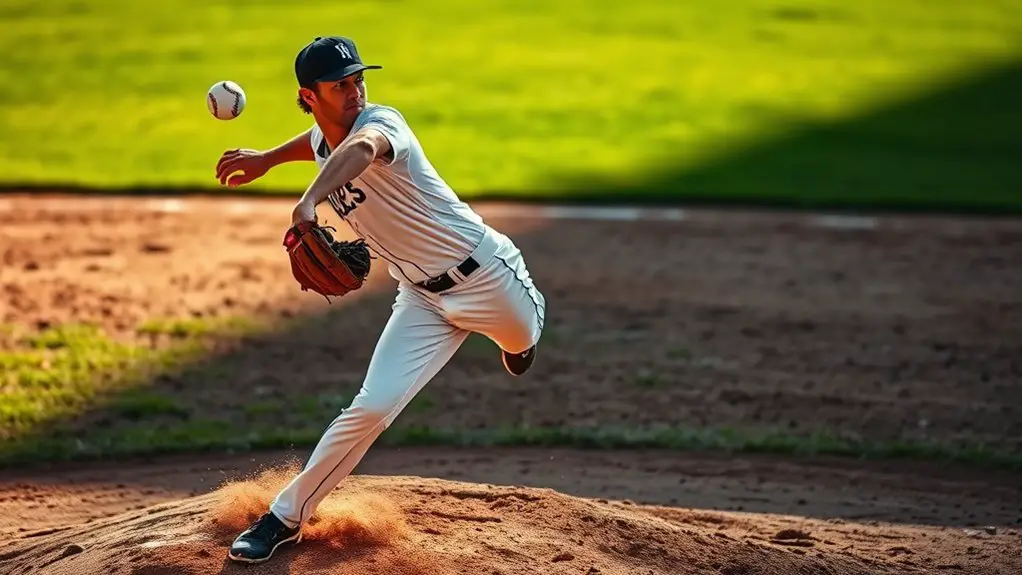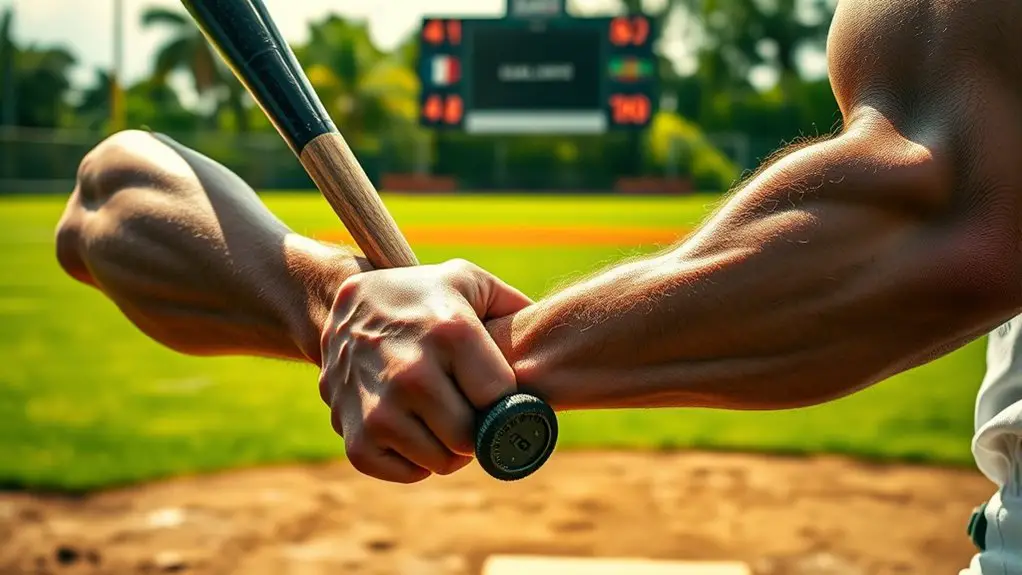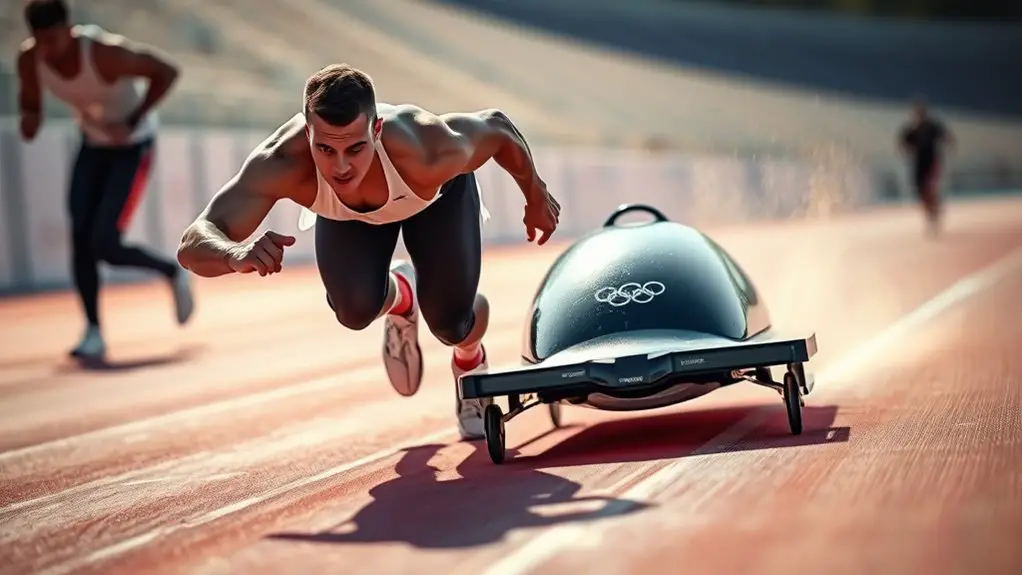The biomechanics of a perfect pitching motion relies heavily on leg strength, hip rotation, and arm positioning. A strong windup generates momentum while engaging your legs for explosive power. Rotating your hips effectively transfers energy upward, enhancing your pitch's velocity and accuracy. Proper arm positioning and a smooth release are vital for maintaining control. Finally, a consistent follow-through not only aids balance but also solidifies your technique. Stick around to discover more about mastering these essential elements.
The Importance of a Strong Windup
A strong windup is essential for any pitcher looking to maximize their performance on the mound. Your windup timing can make all the difference in how effectively you generate momentum. When you master this aspect, you create a rhythm that not only feels natural but also enhances your power and control. Picture yourself flowing smoothly through each phase of the windup, allowing your body to engage fully and build up energy. Incorporating squats and lunges into your training can further strengthen your lower body, providing a solid foundation for an explosive windup.
The Role of Hip Rotation
While many aspects of pitching contribute to overall effectiveness, hip rotation plays a vital role in delivering power and precision. When you engage your hips correctly, you're not just generating force; you're also enhancing your rotational speed. This movement allows your body to transfer energy efficiently from your lower half to your upper half, creating a more dynamic pitch.
Hip flexibility is essential here. The more flexible your hips are, the easier it is to rotate them effectively, which can lead to faster pitch speeds and better control. If your hips are stiff, you're limiting your ability to harness that rotational energy, which could affect your performance on the mound.
Optimal Arm Positioning
When you're pitching, the way your arm is positioned can make a big difference. Proper shoulder alignment and the right elbow angle are essential for maximizing your performance and preventing injury. Let's take a closer look at how these factors play a role in your throwing mechanics.
Shoulder Alignment Importance
Proper shoulder alignment is essential for optimizing pitching performance and preventing injuries. When your shoulders are aligned correctly, you enhance shoulder stability, allowing for a more powerful and fluid motion. This alignment also promotes shoulder mobility, letting you achieve that ideal arm positioning without strain. Think about it: when your shoulders are in sync with your body mechanics, you're not just throwing; you're releasing your full potential. Pay attention to your posture and engage your core to create a solid foundation. This doesn't just improve your pitches; it keeps you free from unnecessary injuries. By focusing on shoulder alignment, you're empowering yourself to pitch with confidence and strength, embracing the freedom that comes with a well-executed motion.
Elbow Angle Considerations
Achieving the right elbow angle is essential for ideal arm positioning during a pitch. You want to guarantee that your elbow stability is at its peak, allowing for a smooth and powerful delivery. Finding the best flexion angle is key; too much or too little can lead to compromised mechanics and increased injury risk. As you wind up, visualize your elbow maintaining a slight bend, providing the necessary support while also enabling a fluid motion. This balance will help maximize your pitch's effectiveness and keep your arm healthy. Remember, perfecting this angle isn't just about power; it's about finding freedom in your movement and allowing your body to work harmoniously through the pitching cycle.
Generating Power From the Legs
Generating power from the legs is essential for a successful pitching motion, as about 60% of the force comes from the lower body. To really release your potential, you need to focus on leg strength and explosive movement. When you dig your cleats into the mound and push off, you're not just using your arm; you're harnessing the power of your legs to drive your pitch.
Start by building your leg strength through exercises that engage your quads, hamstrings, and calves. Think squats, lunges, and plyometrics. These workouts will help you develop that explosive movement, allowing you to transfer energy effectively from your legs to your arm. Incorporating plyometric exercises for power can further enhance your explosive capability on the mound.
When you feel that power surging from your lower body, you'll notice a significant difference in your pitch speed and control. Embrace this freedom in your motion, and let your legs do the heavy lifting!
The Mechanics of Release
As you refine your pitching technique, the mechanics of release play an essential role in your performance. Understanding arm positioning, the importance of a wrist snap, and the follow-through can greatly enhance your pitch's effectiveness. Let's break down these key elements to improve your overall throwing execution.
Arm Positioning Techniques
While mastering arm positioning techniques is essential for effective pitching, understanding the mechanics of release can greatly enhance a pitcher's performance. To achieve ideal arm extension, you want your arm to move fluidly through the throwing motion. This not only improves accuracy but also helps generate velocity. Pay attention to your grip pressure; it should feel secure yet relaxed. Too tight, and you risk losing control; too loose, and you won't get the necessary spin on the ball. As you practice, focus on finding that sweet spot in your grip while maintaining a natural arm slot. When you combine proper arm positioning with a solid release, you'll unleash your potential and truly experience the freedom of pitching mastery.
Wrist Snap Importance
Although the wrist snap might seem like a minor detail, it plays an essential role in the mechanics of release during pitching. Your wrist flexibility and snap timing can greatly influence the ball's velocity and spin. When you master the wrist snap, you unlock your full potential on the mound.
| Aspect | Importance |
|---|---|
| Wrist Flexibility | Allows for a more dynamic snap |
| Snap Timing | Guarantees ideal release speed |
| Ball Control | Enhances pitch accuracy |
A well-executed wrist snap creates a whip-like effect, generating momentum and adding life to your pitches. So, embrace that snap, and you'll find yourself throwing with more power and precision!
Follow-Through Mechanics
The follow-through is an essential phase in the pitching motion, often underestimated despite its significant impact on performance. When you release the ball, the follow-through effects are vital for maintaining balance and control. It's not just about how hard you throw; the way you finish impacts your overall mechanics.
Follow-Through: Ensuring Consistency
As you refine your pitching technique, the follow-through plays an essential role in ensuring consistency. It's not just an afterthought; it's a vital element that can determine your success on the mound. Here are three follow-through techniques to enhance your performance:
- Body Alignment: Keep your body aligned with your target throughout the follow-through to maintain accuracy.
- Fluid Motion: Allow your arm to flow naturally after releasing the ball, promoting a seamless shift and reducing strain.
- Balance Maintenance: Focus on maintaining your balance during the follow-through to set up for your next pitch effectively.
Understanding the follow-through importance can elevate your game, providing you with the freedom to pitch with confidence. A consistent follow-through can help you dial in your control and improve your overall performance, giving you the power to pitch like never before. Embrace these techniques, and watch as your game transforms.
Common Mistakes and How to Avoid Them
While refining your pitching technique, it's easy to overlook common mistakes that can hinder your performance. Identifying these errors is the first step toward improvement. Here's a breakdown of common errors and correction strategies to help you pitch like a pro:
| Common Errors | Correction Strategies | Benefits |
|---|---|---|
| Poor grip on the ball | Experiment with grip types | Better ball control |
| Inconsistent stride | Focus on a uniform stride | Increased power and balance |
| Unstable follow-through | Practice a smooth finish | Enhanced accuracy |
| Over-rotating trunk | Engage your core muscles | Improved stability |
| Not using legs enough | Incorporate leg drive drills | Greater force and distance |
Additionally, focusing on proper warm-up techniques can enhance your overall performance and reduce the risk of injuries.
Frequently Asked Questions
How Can Mental Focus Impact Pitching Performance?
Mental focus can greatly impact your pitching performance. When you harness mental visualization, you can picture each pitch's perfect execution, creating a powerful connection between mind and body. Concentration techniques, like deep breathing or setting clear goals, help you stay present and reduce distractions. By training your mind to focus, you'll find that freedom in your game, allowing your natural talent to shine through, ultimately improving your overall performance on the mound.
What Role Does Flexibility Play in Pitching Mechanics?
They say, "A stiff joint is a weak link." When you're pitching, flexibility plays an essential role in your mechanics. Dynamic stretching before games enhances your joint mobility, allowing for smoother, more powerful movements. It helps prevent injuries, too, giving you the freedom to release your full potential on the mound. So, embrace flexibility in your routine; it's not just about throwing hard, but also about moving fluidly and effectively.
Are There Specific Drills to Improve Pitching Biomechanics?
There are several drill variations you can use to enhance your pitching biomechanics. Focus on exercises that emphasize proper mechanics, like wall throws and resistance band workouts. Incorporating biomechanics analysis can help you pinpoint areas for improvement. You'll find that these drills not only refine your technique but also give you the freedom to express your unique style on the mound. So, get creative and enjoy the process while you practice!
How Does Fatigue Affect Pitching Motion?
When you push your limits, fatigue can creep in like an unwelcome guest. It can sneakily alter your pitching motion, leading to less control and diminished power. The fatigue effects on your muscles can hinder their ability to recover properly, causing your technique to falter. Embracing rest and recovery isn't a sign of weakness; it's a pathway to maintaining that graceful, fluid motion you crave. Prioritize your body, and it'll reward you in the long run.
Can Nutrition Influence a Pitcher's Performance and Mechanics?
Absolutely, nutrition can play a huge role in your performance and mechanics on the mound. Focusing on protein timing can help you recover and build muscle, ensuring your body stays strong. Plus, implementing hydration strategies is essential; staying well-hydrated keeps your joints lubricated and enhances your overall endurance. When you prioritize these elements, you'll not only feel better but also perform at your peak, giving you the freedom to express your pitching style.




